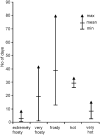Mortality among the homeless: Causes and meteorological relationships
- PMID: 29267330
- PMCID: PMC5739436
- DOI: 10.1371/journal.pone.0189938
Mortality among the homeless: Causes and meteorological relationships
Abstract
Background: The homeless constitute a subpopulation particularly exposed to atmospheric conditions, which, in the temperate climate zone, can result in both cold and heat stress leading to the increased mortality hazard. Environmental conditions have become a significant independent risk factor for mortality from specific causes, including circulatory or respiratory diseases. It is known that this group is particularly prone to some addictions, has a shorter life span, its members often die of different causes than those of the general population and may be especially vulnerable to the influence of weather conditions.
Materials and methods: The retrospective analysis is based on data concerning 615 homeless people, out of which 176 died in the analyzed period (2010-2016). Data for the study was collected in the city of Olsztyn, located in north-east Poland, temperate climatic zone of transitional type. To characterize weather conditions, meteorological data including daily minimum and maximum temperatures and the Universal Thermal Climate Index (UTCI) were used.
Results: The average life span of a homeless person was shorter by about 17.5 years than that recorded for the general population. The average age at death of a homeless male was 56.27 years old (SD 10.38), and 52.00 years old (SD 9.85) of a homeless female. The most frequent causes of death were circulatory system diseases (33.80%). A large number of deaths were attributable to smoking (47.18%), whereas a small number was caused by infectious diseases, while a relatively large proportion of deaths were due to tuberculosis (2.15%). Most deaths occurred in the conditions of cold stress (of different intensity). Deaths caused by hypothermia were thirteen-fold more frequently recorded among the homeless than for the general population. A relative risk of death for a homeless person even in moderate cold stress conditions is higher (RR = 1.84) than in thermoneutral conditions.
Conclusions: Our results indicate excessive mortality among the homeless as well as the weak and rather typical influence of atmospheric conditions on mortality rates in this subpopulation, except for a greater risk of cold related deaths than in the general population. UTCI may serve as a useful tool to predict death risk in this group of people.
Conflict of interest statement
Figures



References
-
- Poland CSOo. Life expectancy 2015. http://stat.gov.pl/obszary-tematyczne/ludnosc/trwanie-zycia/.
-
- Nusselder WJ, Slockers MT, Krol L, Slockers CT, Looman CW, van Beeck EF. Mortality and life expectancy in homeless men and women in Rotterdam: 2001–2010. PLoS One. 2013;8(10):e73979 doi: 10.1371/journal.pone.0073979 - DOI - PMC - PubMed
-
- Vuillermoz C, Aouba A, Grout L, Vandentorren S, Tassin F, Moreno-Betancur M, et al. Mortality among homeless people in France, 2008–10. Eur J Public Health. 2016;26(6):1028–33. doi: 10.1093/eurpub/ckw083 . - DOI - PubMed
-
- Hwang SW. Mortality among men using homeless shelters in Toronto, Ontario. JAMA. 2000;283(16):2152–7. . - PubMed
-
- Baggett TP, Hwang SW, O′Connell JJ, Porneala BC, Stringfellow EJ, Orav EJ, et al. Mortality among homeless adults in Boston: shifts in causes of death over a 15-year period. JAMA Intern Med. 2013;173(3):189–95. doi: 10.1001/jamainternmed.2013.1604 - DOI - PMC - PubMed
Publication types
MeSH terms
LinkOut - more resources
Full Text Sources
Other Literature Sources
Medical

